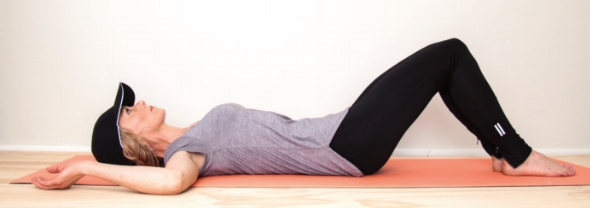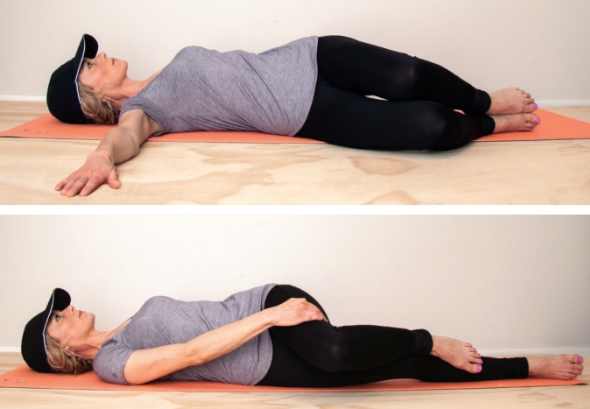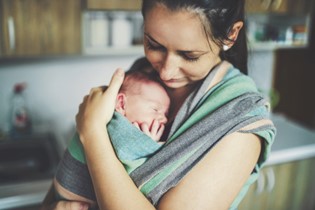How to reconnect with your body

A gentle stretching routine can help you reconnect with your hardworking body and ease tensions common to motherhood. OHbaby! fitness expert Renée Vincent explains how.
During pregnancy, your posture and movement altered completely. And after birth, they changed again. Your new role as a mum may be exciting, and you may find plenty of joy in caring for your new baby, but you'll probably also find that your new ‘job’ is very physically demanding. Mothers perform physical tasks for long hours every day, with little time for self-care and less sleep and rest than ideal, so it is common for mothers to experience pain in their bodies while their children are young.
Repeated postures can cause some areas of the body to tighten and shorten, and others to lengthen, leading to uneven alignment over time. When breastfeeding, for example, you may spend long periods of time sitting with your upper back bent, head down and arms rounded as you cradle and feed your baby. This means that the muscles in your neck, upper back and shoulders are working continuously for the length of the feed, which can leave them feeling tight and eventually painful. Obviously mothers carry their babies repeatedly too, either up on one shoulder or on one hip. Even pushing a stroller requires continuous holding of the handlebar and pushing through the arm, significantly changing your normal walking posture.
However, it’s not all doom and gloom. Our body has an amazing capacity to adapt to these tasks. Stretching is a way to help your body recover, by gently countering these repetitive postures and loads that are part and parcel of being a mum. Research shows that regular stretching can help to relieve back and neck pain —even when that pain has been around for a while. Therefore, building a gentle stretching routine into your day can work wonders to ease areas of tension in your body and keep you feeling great as you meet the physical demands of your role.
Moving mindfully and carefully, with your attention focused on your body, is also a positive way to improve your movement awareness. This is called proprioception, an internal sense that tells you where your body parts are without having to look at them. Proprioception relies on receptors in your joints, muscles, ligaments and connective tissue, which pick up information as they are stretched and moved, and also while they are still. This means that by stretching we are giving our brain information that allows it to outline the contours of our body in our mind. In other words, we are literally ‘re-connecting’ with our body.
While there are many different types of stretching, the routine that follows focuses on static stretching. This type of stretching allows the connecting tissues to lengthen and the muscles to reflexively let go in response to the stretch. We focus on the upper and lower back in this routine, as this is often where mothers experience the most pain.
A gentle stretching routine can help you reconnect with your hardworking body and ease tensions common to motherhood. OHbaby! fitness expert Renée Vincent explains how.
During pregnancy, your posture and movement altered completely. And after birth, they changed again. Your new role as a mum may be exciting, and you may find plenty of joy in caring for your new baby, but you'll probably also find that your new ‘job’ is very physically demanding. Mothers perform physical tasks for long hours every day, with little time for self-care and less sleep and rest than ideal, so it is common for mothers to experience pain in their bodies while their children are young.
Repeated postures can cause some areas of the body to tighten and shorten, and others to lengthen, leading to uneven alignment over time. When breastfeeding, for example, you may spend long periods of time sitting with your upper back bent, head down and arms rounded as you cradle and feed your baby. This means that the muscles in your neck, upper back and shoulders are working continuously for the length of the feed, which can leave them feeling tight and eventually painful. Obviously mothers carry their babies repeatedly too, either up on one shoulder or on one hip. Even pushing a stroller requires continuous holding of the handlebar and pushing through the arm, significantly changing your normal walking posture.
However, it’s not all doom and gloom. Our body has an amazing capacity to adapt to these tasks. Stretching is a way to help your body recover, by gently countering these repetitive postures and loads that are part and parcel of being a mum. Research shows that regular stretching can help to relieve back and neck pain —even when that pain has been around for a while. Therefore, building a gentle stretching routine into your day can work wonders to ease areas of tension in your body and keep you feeling great as you meet the physical demands of your role.
Moving mindfully and carefully, with your attention focused on your body, is also a positive way to improve your movement awareness. This is called proprioception, an internal sense that tells you where your body parts are without having to look at them. Proprioception relies on receptors in your joints, muscles, ligaments and connective tissue, which pick up information as they are stretched and moved, and also while they are still. This means that by stretching we are giving our brain information that allows it to outline the contours of our body in our mind. In other words, we are literally ‘re-connecting’ with our body.
While there are many different types of stretching, the routine that follows focuses on static stretching. This type of stretching allows the connecting tissues to lengthen and the muscles to reflexively let go in response to the stretch. We focus on the upper and lower back in this routine, as this is often where mothers experience the most pain.

AS FEATURED IN ISSUE 31 OF OHbaby! MAGAZINE. CHECK OUT OTHER ARTICLES IN THIS ISSUE BELOW
























